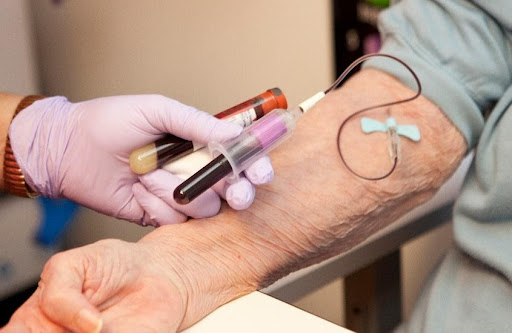Unknown Facts About Northeast Medical Institute - New Haven Campus Phlebotomy Course & Cna Class
Unknown Facts About Northeast Medical Institute - New Haven Campus Phlebotomy Course & Cna Class
Blog Article
Some Ideas on Northeast Medical Institute - New Haven Campus Phlebotomy Course & Cna Class You Should Know
Table of ContentsSome Known Details About Northeast Medical Institute - New Haven Campus Phlebotomy Course & Cna Class The Ultimate Guide To Northeast Medical Institute - New Haven Campus Phlebotomy Course & Cna ClassThe 4-Minute Rule for Northeast Medical Institute - New Haven Campus Phlebotomy Course & Cna ClassGet This Report on Northeast Medical Institute - New Haven Campus Phlebotomy Course & Cna ClassThe 6-Minute Rule for Northeast Medical Institute - New Haven Campus Phlebotomy Course & Cna ClassNortheast Medical Institute - New Haven Campus Phlebotomy Course & Cna Class for Dummies
The use of such tools must be gone along with by other infection avoidance and control practices, and training in their usage.For settings with reduced resources, expense is a motoring element in procurement of safety-engineered devices - CNA Classes. Where safety-engineered devices are not readily available, skilled use a needle and syringe is acceptable. Unexpected exposure and certain information regarding an incident must be tape-recorded in a register. Assistance services must be advertised for those who undertake unintentional direct exposure.
Among the essential pens of top quality of care in phlebotomy is the involvement and collaboration of the individual; this is equally valuable to both the health worker and the patient. Clear information either written or verbal ought to be offered per person that undertakes phlebotomy. Annex F provides example message for clarifying the blood-sampling treatment to a person. labelling); transport problems; analysis of results for professional management. In an outpatient division or facility, give a dedicated phlebotomy cubicle containing: a tidy surface area with two chairs (one for the phlebotomist and the other for the patient); a hand wash container with soap, running water and paper towels; alcohol hand rub. In the blood-sampling area for an outpatient division or center, offer a comfortable reclining sofa with an arm remainder.
The 8-Second Trick For Northeast Medical Institute - New Haven Campus Phlebotomy Course & Cna Class
Make sure that the indications for blood tasting are plainly defined, either in a created protocol or in recorded instructions (e.g. in a research laboratory form). Whatsoever times, follow the techniques for infection avoidance and control listed in Table 2.2. Infection avoidance and control methods. Collect all the tools needed for the procedure and area it within safe and simple reach on a tray or cart, guaranteeing that all the things are plainly visible.
Present on your own to the patient, and ask the client to state their full name. Check that the laboratory form matches the patient's identity (i.e. match the person's information with the research laboratory type, to guarantee precise identification).
Make the client comfortable in a supine position (if feasible). Location a clean paper or towel under the patient's arm. Discuss the examination to be executed (see Annex F) and acquire verbal consent. The patient has a right to reject an examination at any moment prior to the blood tasting, so it is very important to guarantee that the patient has actually understood the procedure.
The smart Trick of Northeast Medical Institute - New Haven Campus Phlebotomy Course & Cna Class That Nobody is Discussing
Extend the client's arm and check the antecubital fossa or lower arm. Find a blood vessel of an excellent dimension that is noticeable, straight and clear.
DO NOT insert the needle where veins are diverting, due to the fact that this raises the opportunity of a haematoma. Finding the capillary will help in determining the correct dimension of needle.
Specimens from main lines carry a threat of contamination or erroneous research laboratory test outcomes. It is appropriate, but not suitable, to draw blood specimens when initial introducing an in-dwelling venous device, before connecting the cannula to the intravenous liquids.
The 10-Second Trick For Northeast Medical Institute - New Haven Campus Phlebotomy Course & Cna Class
Permit the area to completely dry. Failing to permit sufficient contact time enhances the danger of contamination. DO NOT touch the cleaned up site; particularly, DO NOT put a finger over the capillary to assist the shaft of the revealed needle. It the website is touched, repeat the sanitation. Do venepuncture as complies with.
Ask the individual to develop a clenched fist so the capillaries are much more noticeable. Enter the capillary quickly at a 30 degree angle or much less, and remain to present the needle along the vein at the easiest angle of entry - CNA Courses. As soon as enough blood has been collected, launch the tourniquet prior to withdrawing the needle
Unknown Facts About Northeast Medical Institute - New Haven Campus Phlebotomy Course & Cna Class
Take out the needle gently and use mild pressure to the site with a tidy gauze or dry cotton-wool sphere. Ask the patient to hold the gauze or cotton woollen in place, with the arm prolonged and elevated. Ask the client NOT to flex the arm, due to the fact that doing so triggers a haematoma.
:max_bytes(150000):strip_icc()/Primary_Image-b2e24c37575f48279cff673865d3853c.jpg)
Getting The Northeast Medical Institute - New Haven Campus Phlebotomy Course & Cna Class To Work
Do not press the syringe plunger because extra stress raises the risk of haemolysis. Where possible, keep the tubes in a rack and move the shelf in the direction of you. Infuse downwards into the appropriate coloured stopper. DO NOT remove the stopper because it will release the vacuum. If the example tube does not have a rubber stopper, infuse extremely gradually right into television as decreasing the stress and rate made use of to move the sampling minimizes the danger of haemolysis.

Report this page